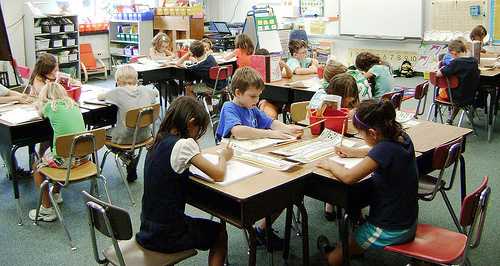Hunger In Our Schools: Breakfast Is A Crucial “School Supply” For Kids In Need
Ed. Note: This is a cross post from the blog of usda.gov. You can find the original post here.
"Good nutrition is just as important to a child’s future as a quality education—maybe even more so. We can’t expect kids to learn, excel and achieve if they aren’t properly nourished from day one. Share Our Strength’s new report, Hunger in Our Schools, illustrates how the healthier school breakfasts and lunches are working to address the twin crises of childhood hunger and obesity, particularly for low-income children. Healthy meals set up our kids for success, and school meals are a critical and effective part of that." –Secretary Tom Vilsack
As a nation, we spend a lot of time, effort and money on ways to better educate our children. In recent years, there have been fierce debates on No Child Left Behind, Common Core, teacher qualifications, textbook standards and more. These battles ignore one key factor, however: If our children are too hungry to learn, their success is doomed before we’ve even begun.
Working with the research firm SalterMitchell, No Kid Hungry recently completed a new national survey of 1,000+ educators across the nation as well as a series of focus group interviews with dozens of teachers and principals. The new report, “Hunger In Our Schools,” underscores the fact that hunger hampers a child’s ability to learn, but school breakfast offers a chance to solve this problem for millions of children.
At a time when a majority of America’s public school students come from low-income backgrounds, childhood hunger is a reality in American public schools. Among educators surveyed in the report, 76 percent say they have students who regularly come to school hungry.

A healthy breakfast is a critical school supply. Just as you would never expect a student to excel without access to their textbooks, we can’t expect them to excel without the daily fuel they need for their brains and bodies.
A healthy breakfast is a critical school supply. Just as you would never expect a student to excel without access to their textbooks, we can’t expect them to excel without the daily fuel they need for their brains and bodies. As teacher Tony Notarides told interviewers, “The problem of hunger leads to all of these other problems. It has a snowball effect. These students fall behind and they never really catch up.”
In fact, educators who regularly see children come to school hungry describe seeing long list of associated effects, including an inability to concentrate (88%), a lack of motivation (87%), behavioral problems (65%), illness (53%) and poor academic performance (84%). “It’s heartbreaking when I can’t do my job because my students are hungry,” said third-grade teacher Audrey Harris.
Hunger in our schools, however, is a solvable problem. School breakfast is a critical but underutilized national program that bears a direct impact of children’s academic achievement and health. Nine out of ten educators in the Hunger In Our Schools survey say breakfast is critical to academic achievement, and 97% of educators say it’s important that children from low-income families have access to free, healthy breakfasts during the school year. This is borne out by research; a study conducted by Deloitte Consulting shows that when kids consistently eat breakfast at school, attendance rates improve and test scores rise.
The trouble is making sure children who need this meal are able to access it. Parents, kids, and school leaders cite a variety of barriers such as stigma of eating breakfast alone in the cafeteria; transportation problems (buses not delivering kids to school in time for breakfast); and misperceptions about the value of serving breakfast in new ways (such as serving it in the classroom as part of first period) as reasons why more low-income kids aren’t getting this vital meal as intended.
Many schools have found better ways to feed children. One particularly effective way is to move breakfast out of the cafeteria and makes it a seamless part of the school day for students. Of those teachers who have classroom breakfast programs, 75% say the program has been positive experience for their students. After bringing breakfast into their classrooms, three out of four teachers surveyed say students were more alert, while half said they saw discipline problems drop and attendance improve.
After instituting breakfast in her classroom, first-grade teacher Margot Shaver sees an immediate response in her students: “The light turns on; they’re able to function in the classroom.”
It’s time to turn the light on for more students. We can wipe out hunger for more students in more schools, but we must work together.
Tom Nelson is the President of Share Our Strength, the national non-profit working to end childhood hunger in America through its No Kid Hungry campaign. Using proven, practical solutions, No Kid Hungry is ending childhood hunger today by ensuring that kids start the day with a nutritious breakfast and families learn the skills they need to shop and cook on a budget. When we all work together, we can make sure kids get the healthy food they need. No Kid Hungry is a campaign of national anti-hunger organization Share Our Strength. Join us at NoKidHungry.org.
